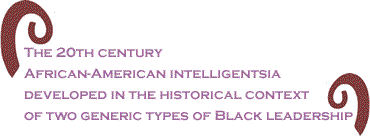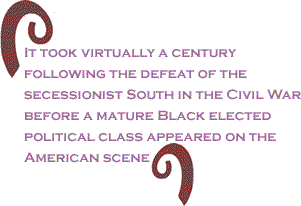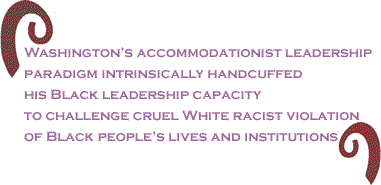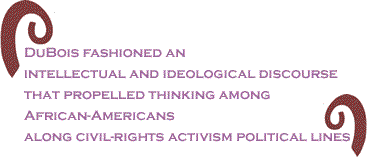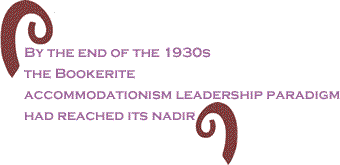
|
|||||||||||||||||||||
 |
|
|
Part Two of Dr. Kilson's article will appear in the March 2nd issue of BC. The development of the 20th century African-American intelligentsia occurred in the unique historical context of a White supremacist defined status for Black American citizens. The 20th century African-American intelligentsia also developed in the historical context of two generic types of Black leadership that evolved among African-Americans from the end of Reconstruction in the late 1890s into the World War II era. This two-part article provides a retrospective overview diagnosis of the two core leadership methods associated with the African-American intelligentsia personalities of Booker T. Washington - an educator who headed an Emancipation Era Negro college, Tuskegee Institute in Alabama - and W.E.B. DuBois - a university scholar who fashioned and executed a civil rights activism challenge of the American racist edifice. The Washingtonian/DuBoisian Black leadership contest shaped important facets of the political and ideological contours of the Black intelligentsia in general and of particular Black intellectuals during the first half of the 20th century. Accordingly, an understanding of key features of the Washingtonian/DuBoisian leadership dynamics provides a foundation for a clearer view of more complex Black leadership dynamics confronting African-American society as it enters the 21st century. From the late 19th century through the first two decades of the 20th century, the leadership paradigm associated with Booker T. Washington - one of not challenging the American racist edifice head-on - had a substantial presence among the African-American intelligentsia. By the 1940s onward, however, the leadership paradigm associated with W.E.B. DuBois and the National Association for the Advancement of Colored People (NAACP), which he served, achieved prominent status among the ranks of the African-American intelligentsia. Historical Background to Black Leadership Fast upon the defeat of the secessionist Southern states after the Civil War, the federal government instituted a policy of political incorporation of the formerly enslaved Negro population into the American social order - the policy of Reconstruction. As W. E.B. DuBois demonstrates in his great work Black Reconstruction in America, 1860-1880 (New York: Harcourt Brace, 1935), that policy provided the formerly enslaved Negro a variety of experiences with democratic practices. And in South Carolina where Negro voters were in the majority, democratic practices under Reconstruction were on the highest level, as the University of Chicago historian Thomas Holt demonstrates in his profound work Black over White: Negro Political Leadership in South Carolina During Reconstruction (Chicago: University of Chicago Press, 1977). However, the loss of federal government support for Reconstruction - it's betrayal by the federal government in fact - by the early 1880s resulted in the rise of authoritarian and violent restorationist Southern forces. By the late-1880s these restorationist forces were well on the way toward disenfranchising Black citizens throughout the South, thereby replacing Reconstruction with what can only be called the imposition of an authoritarian system of political control of White Americans over Black Americans in Southern states. Owing to the federal government's unwillingness to sustain Blacks' voting rights and protect their human rights in Southern states, whatever leadership practices that evolved among African-Americans from the 1890s onward had to confront this massive systemic political deficiency.
Furthermore, although outside the South - where by 1910 around 10% of Blacks had settled - a state-supported political authoritarian pattern was not arraigned against African-Americans, a broad range of White-hegemonic political maneuvers prevailed in the North which restricted equal access to democratic participation by African-Americans. This resulted in a three-generation delay in the production of a full-fledged Black elected political class for African-American communities in the North. So, in general, for Blacks both in the South and in the North, it was not until the passage of the major civil rights legislation of the middle 1960s and later that the typical Black citizen could claim full citizenship and electoral participation rights. Put another way, it took virtually a century - five generations - following the defeat of the secessionist South in the Civil War before a mature Black elected political class appeared on the American scene. For example, when the Voting Rights Act of 1965 was enacted, only about 350 Black elected officials existed nationwide, serving the citizenship needs of an African-American population that numbered about 20 million. Returning to the vantage point of the 1880s, the formerly enslaved Negro population was nursing the betrayal of Reconstruction policy by the American system, resulting in African-Americans being a disheveled and weak American ethnic community in regard to its leadership and institutional processes. Apart from American Indians, African-Americans were the only major American ethnic group prevented by American laws from viably intertwining their ethnic group leadership patterns (their communal and societal agencies) with the systemic political processes that governed the evolving American industrial social system during the late 19th and early 20th century. On the other hand, Irish-Americans, Italian-Americans, Jewish-Americans, White Anglo-Saxon Protestant Americans (WASPS) and other White groups were allowed to interlock their ethnic group leadership agencies with the system-wide American political processes, at town, city, county, state, and federal levels. Thinking About How to Lead Early 20th Century Blacks It was, then, because of the racist citizenship-status difference between the citizenship attributes of African-Americans and White Americans that the phenomenon of a Booker T. Washington/W.E.B. DuBois leadership paradigm conflict emerged in the first place. No White ethnic group experienced this kind of core leadership conflict as they faced the task of transforming themselves into viable American ethnic communities, as their members strove to become effective participants in the evolving industrial American society of the late 19th and early 20th century. Only African-Americans had to go back to square one, so to speak, in order to tackle the question of how do you lead the formerly enslaved Negro population as it seeks to participate in a raucously industrializing American society - the "Robber Baron" era America - a capitalist America that was buffeting human beings to-and-fro like leaves in the wind. Owing to the White supremacist marginalization and pariahization of the Negro in America from the late 19th century through the first half of the 20th century, creating an effective African-American leadership strategy was difficult to realize. Accordingly, at the dawn of the Emancipation era, the embryonic Black American intelligentsia - barely a handful of secondary school and higher educated persons - confronted the question: "How do you lead the formerly enslaved Negro American?" Let me address this profound issue initially by way of a brief reference to my own ancestral origins among that stratum of pre-Civil War era Blacks known by the U.S. Census Bureau label "Free Negro Heads of Household." My paternal great-great grandfather was an African Methodist Episcopal clergyman (Rev. Isaac Lee) who was born in the early 1800s among Free Negro communities in Eastern Shore counties of Maryland. He was a landowning farmer who, in the late 1840s, mortgaged his land to build the first African Methodist Episcopal Church in Kent County, Maryland. He also supported the abolitionist movement and members of his clan joined the Union Army to help free the Negro from slavery. On my maternal side, my great-grandfather (Jacob
Laws) helped to build and sustain modern communities among Free
Negroes before the Civil War in Maryland, Delaware, and What does this brief tale of my ancestors tell us about the interaction between the Booker T. Washington and the W.E.B. DuBois leadership methods that addressed the generic issue - "How do you lead the formerly enslaved Negro American?" I think this brief ancestral tale provides us a thumbs-nail historical framework for identifying core social system dynamics that confronted African-Americans from the 1880s into the early 20th century. From this brief ancestral tale, I suggest that we can posit at least two essential functions of modern ethnic community leadership. One basic leadership function can be characterized by the term that anthropologists often use - "social organization." What might be called "social organization-leadership" is concerned with fashioning the nuts-and-bolts of an ethnic group's social system, with fashioning the infrastructure of modern development. A second basic leadership function is to offer guidance and goals to direct a modern ethnic group toward desired ends. This leadership function is concerned mainly with an ethnic group's status, rights, and honor within a modern nation-state society like the United States. This second leadership function might be called the guidance-type or mobilization-type leadership, and it is from this second leadership function that civil-rights activist leadership and elected politician leadership evolved.
In general, for African-Americans the end of Reconstruction from the 1880s onward placed a barrier to the natural growth of guidance or mobilization-type leadership. Within the South where the vast majority of Blacks resided between the 1890s and the end of World War II, mobilization-type leadership was brutally restricted by authoritarian racist practices. For example, by 1940 only 5% of the voting-age Black population in the South had been allowed to become registered voters. White violence and bureaucratic coercion (judicial and police) were employed to impose this lowest level political participation on African-American citizens. As a result, a massive federal government intervention was required to alter this situation (which finally came with the Voting Rights Act of 1965), and meanwhile the majority population of African-Americans in the South had to resort to a more embryonic form of leadership that I call "social-organization type leadership." The major variant of social-organization type leadership was articulated along systemic lines by the most prominent African-American leadership figure in the South from the late 1880s to his death in 1915. That figure was Booker T. Washington. The Washington Leadership Paradigm If we could magically transport ourselves back 100 years or so to Atlanta, Georgia, in 1895, we would have experienced an extraordinary event. That event would shape the metamorphosis of leadership dynamics for the recently emancipated Negro population from the late 1890s through the first half of the 20th century. The extraordinary event I refer to was the presence of Booker T. Washington at the capitalist industrial Atlanta Exposition in 1895. Washington told an audience of White entrepreneurs - the leading figures of an exploding American industrial economy - that all they had to worry about in regard to a troublesome American working class was the White working class. As Washington was well aware, the White working class had or could bid for full citizenship status (that is, they were within the American social contract) and thus could participate in helping to define the evolving industrial nation-state's public purposes. But what about the recently emancipated Negro population? Above all, in 1895 the Black working class was almost totally excluded from the American social contract - and brutally excluded at that. Most (over 90%) of the African-American working class was an oppressed agrarian proletarian whom historians, cognizant of its dilapidated attributes, labeled a peonage agrarian class. In other words, the African-American working class was not just overwhelmed by massive social oppression but overwhelmed as well by judicial, police, and political oppression. The cruelest kind of systemic oppression under American capitalism was endured by the Southern branch of the African-American population, perhaps one-third of whom faced the horrible experience of prison labor from the 1890s to World War II, the horrific threat of imprisonment for the purpose of becoming prison labor, a practice graphically revealed in David Oshinsky's Worse Than Slavery: Parchman Farm and the Ordeal of Jim Crow Justice (New York: Oxford University Press, 1995). Booker T. Washington's message to the assembled
industrial capitalists was at the other end of the political spectrum
from what that young African-American who was just finishing his
doctorate degree at Harvard University in 1895 - W.E. B. DuBois
- would have told the Atlanta Exposition participants had he been
invited to it. In direct reference to the core query - "How
do you lead formerly enslaved Negro Americans?" - From these groundwork propositions, then, Booker T. Washington sought to strike a bargain with America's captains of industry and, through them, with America's operational authoritarian White supremacist overrule of some 10 million recently emancipated Negroes. Washington opined that if the White elites in the South and North would funnel financial and institutional resources to what I call his social-organization Black leadership model, this Washingtonian brand of Black leadership would, on the one hand, advance the African-American social system while, on the other hand, neglect the quest for full-fledged citizenship status and human rights status - rights that were by 1895 some thirty years old, enshrined in the United States Constitution on pain of a bloody Civil War and elaborated by federal legislation known as the Civil Rights Codes of 1865, 1866, and 1867. In his major work The Future of the Race (1902), Booker T. Washington presented his accommodationist formulations as follows:
Several years into the 20th century - in 1904 - the progressive Black journalist Ida Wells-Barnett rebuked Booker T. Washington for pronouncing what she derisively termed his "gospel of work" ("Start…a dairy farm or truck garden," he advised the recently emancipated Negro masses), because it was an insult to Black people's honor. After all, she observed, hard work was forcefully imposed on Black people during two centuries of American slavocracy, so they needed no advice about hard and creative work from Booker T. Washington. Instead, what they needed from Washington was steadfast leadership that advanced full-fledged citizenship rights and human rights for the recently emancipated Negro. (See Linda Murray, To Keep the Waters Troubled: The Life of Ida B. Wells (1998) p. 263)
Furthermore, there was in Booker T. Washington's accommodationist schema no timetable for the establishment of African-American citizenship and human rights parity. Writing in the classic appraisal of African-American citizenship status as of the middle 1940s produced by the Carnegie Foundation study An American Dilemma:The Negro Problem and Modern Democracy (1944), Gunnar Myrdal reflected on Booker T. Washington's leadership model as follows:
Moreover, as a result of Washington's accommodationist leadership paradigm's open-ended surrender of Black people's citizenship and human rights, both the White power class and masses in the South considered themselves free to smash any organizational or institutional legacy of that brief democracy era for Negroes under Reconstruction. Their White supremacist ethos drove them to do so often from the 1880s onward, one cruel and vicious instance of which took place just three years after Booker T. Washington's much vaunted 1895 Atlanta Exposition address. This was in November 1898 in Wilmington, North Carolina. A recent 500-page monograph on an anti-Negro riot in Wilmington in 1898 (reported on in the New York Times (December 21, 2005)) relates the massive assault against the Black population of what was then North Carolina's largest city, a population numbering 3,478 Blacks or 49% of Wilmington. The New York Times report on the monograph observed as follows:
Booker T. Washington was not publicly heard from in regard to this monstrous assault against one of North Carolina's largest Black communities in 1898, nor was he heard from publicly eight years later - in 1906 - when the Atlanta, Georgia, Black community was similarly assaulted by a riotous White population. Why? Because Washington's accommodationist leadership paradigm intrinsically handcuffed his Black leadership capacity to challenge such cruel White racist violation of Black people's lives and institutions. And, mind you, there were innumerable instances of such authoritarian and terrorist White assaults against Black citizens between Booker T. Washington's 1895 Atlanta Exposition address and his death in 1915, and in all of these instances Washington's leadership voice was mute. It was precisely because of this that, following Booker T. Washington's death, Rev. Francis Grimke, who pastored the leading Black Presbyterian church in the country's capitol, reflected in a scathing manner on Washington's leadership legacy. Writing in his Meditations, Grimke bitterly observed:
Nonetheless, we must keep in mind that Booker T. Washington was not, of course, a simpleton. His surrendering-of-Black-people's-rights accommodationist leadership strategy did have a certain kind of rational semblance, after a fashion. Above all, Booker T. Washington understood that if he could get the American elites, from 1895 onward, to generate financial and institutional resources to advance Blacks in education, job opportunities, and neighborhood uplift, this very process of social system development might eventually converge with the American political system. However, given his autocratic leadership persona - a persona keenly probed in Louis Harlan's Booker T. Washington: The Making of a Black Leader, 1856-1901 (New York: Oxford University Press, 1972) - Washington felt no responsibility to engage the politics underlying a process of consolidating African-Americans' social development with their full-fledged citizenship and human rights. Such an engagement of politics would have required Washington to fashion some form of civil rights activism, a political profile he never adopted. Instead, Booker T. Washington fashioned himself to be the top client-type Black leadership personality vis-à-vis the national White power class. Upon acquiring a patron-client Black leadership interaction with the conservative national White power class, Washington functioned as the main advisor to the White power class on crucial issues related to African-Americans' racist status in the American system. Such issues as the status of working-class Blacks in the agrarian South and the industrial North (Washington opposed trade unions for Black workers, for example), and issues relating to Black's citizenship and human rights. Thus, by World War I, what historians have labeled the accommodationism leadership method of Booker T. Washington provided virtually nothing in the form of a Black political challenge to America's White supremacist edifice. Furthermore, at the time of Booker T. Washington's death in 1915, some 95% of 11 million Blacks in the United States were massively poor. The bargain or compromise that Washington struck with White elites in regard to opening up industrial job markets for Black workers - in exchange for Washington's leadership method of keeping Black Americans quiet regarding their constitutional citizenship rights - was an utter failure, because the White capitalist elites made no serious effort to incorporate Black workers at parity with White workers. Neither was the other facet of Washington's compromise arrangement with White elites given serious attention by White elites - namely, the goal of expanding education for the illiterate offspring of Negro slaves. Of course, Booker T. Washington made an important contribution toward advancing education for African-Americans through his leadership of Tuskegee Institute from the 1880s to his death in 1915. But the vast majority of the Southern Black population was wretchedly educated by the 1930s, as Horace Mann Bond revealed in his brilliant works on this topic, Education of the Negro in the American Social Order (New York: Prentice Hall, 1934) and Negro Education in Alabama (Washington, D.C.: Associated Publishers,1939). Again, the White elites in American industry and commerce with whom Booker T. Washington struck his accommodationism compromise reneged on their side of that Faustian bargain, failing to produce anything resembling adequate private or public resources to advance industrial-skill education for African-Americans.
I suggest, therefore, that in opting for the "social-organization type" Black leadership, Booker T. Washington painted himself and African-Americans generally into what might be called a leadership cul-de-sac. Under Washington's leadership paradigm, Black leadership surrendered the political weapon of a challenge-response to America's White supremacist edifice, on the one hand, but on the other hand failed to gain in exchange from White elites adequate resources to advance industrial-skill education for African-Americans. The miniscule resources White elites did supply to Booker T. Washington by 1915 went mainly to his autocratically controlled Tuskegee Institute and his national-level business organization and political machine, the Negro Business League. I believe that had Booker T. Washington lived into the World War II era, the political consequences of his leadership paradigm would have been devastating for the nature of the citizenship and human rights status of African-Americans. In particular, the fashioning of a "mobilization-type" Black leadership methodology - the methodology that mounted legal and social movement challenges to American racism - would have been hampered and seriously delayed for several generations. Fortunately, however, this dire outcome was averted, owing to the fashioning of a politically viable "mobilization-type" Black leadership under the intellectual initiative of a small cadre of African-American intelligentsia personalities who revolved around W.E. B. DuBois. Those personalities included the best and brightest among the embryonic early 20th century African-American intelligentsia - personalities like Monroe Trotter (editor of The Boston Guardian, a Negro weekly), Ida Wells-Barnett (journalist), Archibald Grimke (lawyer), Clement Morgan (lawyer), James Weldon Johnson (lawyer and writer), Anna Julia Cooper (activist educator), J. Max Barber (editor of Voice of the Negro, an Atlanta weekly), John Wesley Cromwell (editor of The People's Voice, a Negro weekly in Washington, D.C.), Rev. Francis Grimke (a leading Black Presbyterian clergyman), Rev. Reverdy Ransom (a leading African Methodist Episcopal clergyman), among others. These personalities helped to launch and/or supported the Niagara Movement in 1905 as an activist political antidote to Booker T. Washington's accommodationist leadership paradigm, and in 1909 they rallied around the founding of the National Association for the Advancement of Colored People. Addressing the second gathering of the Niagara Movement in 1906 - which occurred for the first time on American soil in Harpers Ferry, Virginia - Rev. Reverdy Ransom (later, in 1924, AME Bishop Ransom) delivered a riveting address in which he astutely delineated the political substance underlying the then two key competing Negro American leadership paradigms:
The W.E.B. DuBois Leadership Paradigm
The mainstream Black leadership as we know it today (what I call the pragmatic-activist strand among the African-American professional class as represented by the major civil rights organizations and by numerous professional associations) owes a great deal to W.E.B. DuBois. Through writing an early Negro activism manifesto, The Souls of Black Folk in 1903, launching the Niagara Movement in 1905, helping to fashion the NAACP in 1909, and playing a leading role in executing the NAACP's civil rights activism into the World War II era, W.E.B. DuBois demonstrated the political efficacy of the "mobilization-type" Black leadership paradigm. There were several core political features of DuBois' "mobilization-type" Black leadership paradigm. First, he fashioned an intellectual and ideological discourse that propelled thinking among African-Americans along civil-rights activism political lines. This Negro activism discourse, let's call it, encouraged broad numbers of African-Americans to think critically toward the citizenship and human rights surrender attributes of Booker T. Washington's accommodationist leadership. From the early 20th century onward, this Negro activism discourse was shaped and propagated widely in African-American communities - in the North especially and occasionally in the South - through weekly newspapers, such as the New York Age, Philadelphia Tribune, Cleveland Call and Post, People's Voice in Washington, D.C., the Chicago Defender, the Baltimore Afro-American, Voice of the Negro in Atlanta, to mention just a few. Second, DuBois facilitated a corollary intellectual and ideological discourse among African-Americans that upheld Black-people's honor. This discourse fervently challenged the presumption held by most White Americans that defaming African-Americans' cultural presence in American society was their natural privilege as White people. Furthermore, through his brilliant editorship from 1910 to 1933 of the NAACP's monthly journal, The Crisis, DuBois helped to propagate a Negro activism discourse and its corollary Negro-people's honor discourse. Additionally, as Elliott Rudwick demonstrates in W.E.B. DuBois: A Study in Minority Group Leadership (Philadelphia: University of Pennsylvania Press, 1960), DuBois's long editorship of The Crisis provided him a platform for fashioning strategies for hands-on civil rights activism that challenged the American White supremacist edifice. DuBois pioneered direct-action civil rights advancement strategies such as the first March-on-Washington Movement during World War I, whose purpose was to let the White supremacist federal government under President Woodrow Wilson know that Black Americans were deadly serious about gaining full-fledged citizenship rights, so serious that they demanded the right to fight America's wars and thus the right to die for America. This instance of civil rights activism associated with DuBois's leadership paradigm eventually translated into a variety of direct-action civil rights advancement strategies. One pattern of direct-action civil rights advancement was institutionalized under the leadership of the brilliant civil rights lawyer Charles Hamilton Houston, who, while dean of Howard University Law School in the 1930s, influenced the NAACP to launch the NAACP Legal Defense Fund, which he initially directed. Professor Houston also trained a generation of talented African-American law students at Howard University, such as James Nabrit, Spottswood Robinson, and Thurgood Marshall - later a U.S. Supreme Court Justice - who used the NAACP Legal Defense Fund as an agency for mounting numerous legal challenges to the racist legal edifice underpinning segregation and discrimination in American life, a development related in Genna Rae McNeil's Groundwork: Charles Hamilton Houston and the Struggle for Civil Rights (Philadelphia: University of Pennsylvania Press, 1983). Houston's proteges Marshall and Nabrit led a battery of NAACP Legal Defense Fund lawyers in challenging segregation in public schools before the U.S. Supreme Court, a challenge that was victorious when the U.S. Supreme Court's 1954 decision in Brown v. Board of Education overruled the 1896 decision in Plessy v. Ferguson that upheld segregation in public schooling. This U.S. Supreme Court decision was a capstone event, one that placed the U.S. Constitution on the side of equal access to public schooling for African-Americans. I believe that this juridical dismantling of American racism in public education would not have seen the light of day by the 1950s had the Booker T. Washington accommodationist leadership paradigm, rather than the DuBoisian leadership paradigm, gained primacy in the ranks of the African-American intelligentsia during the first half of the 20th century. This perspective is suggested by the Harvard Law School scholar Professor Charles Ogletree, in his seminal retrospective on the U.S. Supreme Court's historic Brown v. Board of Education decision titled All Deliberate Speed: Reflections on the First Half Century of Brown v. Board of Education (New York: W.W. Norton Co., New York, 2004). DuBoisian Activism and Black Civil Society Advancement It must be noted, however, that while the DuBoisian leadership paradigm's primary focus revolved around direct-action civil rights advancement strategies, this was not the totality of this leadership paradigm's approach to African-American development. Concerns relating to the advancement of the core agencies of African-American civil society were central to W.E.B. DuBois at the very dawn of his leadership career. By the term "Black civil society agencies," I refer to a variety of Black people's societal and institution-forging agencies such as women's clubs, mutual aid associations, churches, clergy associations, professional associations (among doctors, lawyers, teachers, etc.), business associations, fraternal associations among men and sororities among women, business associations, trade unions, etc.
The young DuBois expressed a fervent interest in the furtherance of such Black civil society agencies in his first Black leadership manifesto in 1903 - The Souls of Black Folk. For example, in Chapter IV titled "Of the Meaning of Progress," DuBois relates the excitement he derived from joining a group of Fisk University students who spent a college semester teaching in rural Negro communities in Tennessee. And in Chapter VI titled "Of the Training of Black Men," DuBois underlines the crucial role of early Negro colleges in preparing the sons of former slaves with technical and intellectual skills. Even before the publication of The Souls of Black Folk, DuBois published a small study titled The College-Bred Negro (Atlanta, 1900) which related the role of the small cadre of Negro college-trained Blacks in laying the foundation of Black civil society agencies. This study was followed by other small studies on specific Black civil society agencies such as Negro churches and Negro artisans. Furthermore, as DuBois's major biographer David Levering Lewis relates in his second volume on DuBois's career - W.E.B. DuBois: The Fight for Equality and the American Century, 1919-1963 (New York: Henry Holt, 2000) - by the early 1930s DuBois was weary regarding the rather miniscule victories against the American racist edifice chalked up by the NAACP's civil rights activism strategy. One response to this situation by DuBois was to goad the NAACP leadership toward a more assertive attention to advancing Black civil society agencies. So assertive, in fact, that key NAACP leaders like Walter White (Secretary), Roy Wilkins (Assistant Secretary), and Joel Spingarn (President) rebuked DuBois for pressing a "Negro separatist" agenda. Writing in an article titled "Segregation" in The Crisis (January 1934), DuBois, while continuing to support the NAACP's civil rights activism strategy, emphasized the need for "race-conscious black cooperating together in his own institutions and movements [in order to]…organize and conduct enterprises." Furthermore, DuBois observed that his Black-communitarian orientation was nothing new or radical because "the vast majority of the Negroes in the United States are born in colored homes, educated in separate colored schools, attend separate colored churches, marry colored mates, and find their amusements in colored YMCA' and YWCA's." By the 1930s important elements among the African-American middle class and professional stratum who had ideologically embraced the NAACP's civil rights activism perspective also contributed to the simultaneous advancement of communitarian or civil society aspects of African-American life. Among those 1930s contributors to Black communitarian advancement were the National Negro Bar Association, the National Association of Colored Women, major urban Negro churches, and the Negro Elks, among others. In a chapter titled "Dynamics of the Black Church and Clergy in the African-American Intelligentsia" for my forthcoming book The Making of Black Intellectuals, I discuss in some detail the contribution of Negro churches and clergy in advancing the communitarian or civil society aspects of African-American life during the 1930s into the World War II era and later - clergy like Rev. J. C. Austin of Pilgrim Baptist Church in Chicago and Rev. Robert Bradby of Second Baptist Church in Detroit. During this same period the Negro Elks made major contributions to the advancement of health services in urban Black communities. An article in The AME Church Review (April-June 2004) on the Negro Elks by the Vanderbilt University historian Dennis Dickerson - titled "Medicine for the Masses: The Health Commission of the…[Negro] Elks, 1927-1952" - described the 100,000-member Negro Elks' medical services that were organized through 699 Elks Lodges in 451 towns and cities in the United States. Other civil rights oriented middle-class Black organizations also contributed to communitarian advancement in Black communities in the era between the two World Wars, such as Negro Greek Letter organizations whose activities in Philadelphia are described in Vincent Franklin's seminal study The Education of Black Philadelphia (1979) as follows:
Thus, from the 1920s through the 1930s onward, a variety of middle-class Black organizations who shared the DuBoisian civil rights activism outlook, were engaged in numerous functions that generated and expanded African-Americans' communitarian and civil society institutions. During the important period between the two World Wars, the sector among middle-class Blacks who identified with the Booker T. Washington accommodationism ideology did not exercise a preeminent position in generating communitarian and civil society institutions among African-Americans. The claim by spokesmen for the Washingtonian accommodationism leadership perspective - like Emmett Scott and Robert Moton - that their followers performed better in generating Black civil society growth because they did not devote their energies to civil rights activism challenges of American racism, was bogus. A Concluding Note for Part I
It should be noted that by the 1930s onward, a variety of personalities among Black American intellectuals had rallied Negro college campuses to the DuBoisian civil rights activism leadership perspective. This important development had its origins in the post-World War I years onward, centered in New York City's Negro community of Harlem, as related in David Levering Lewis's seminal work When Harlem was in Vogue (New York: Penguin Books, 1997), which relates the rise of the New Negro Movement or Harlem Renaissance Movement. The spread of civil rights activism ideas had a very special impact among Black students on many Negro college campuses from the 1920s onward - a subject treated in Raymond Wolter's important book The New Negro on Campus: Black Students' Protests in the 1920s (Princeton: Princeton University Press, 1975). This development fundamentally redefined the role of Negro college activities in the overall life of Black civil society from the 1930s onward. Thus, by the end of the 1930s the Bookerite accommodationism leadership paradigm had reached its nadir. Accordingly, by the end of World War II, the DuBoisian civil rights activism leadership perspective had impacted broadly upon a wide range of Black civil society institutions, such as Negro colleges, business organizations, professional associations, women's organizations, trade unions (e.g., A. Philip Randolph's Brotherhood of Sleeping Car Porters), mutual aid associations, and churches. It was, I think, this coalescence of the DuBoisian civil rights activism leadership perspective, on the one hand, and, on the other hand, numerous Black civil society institutions that prepared the way for a new version of the DuBoisian leadership paradigm during the post-World War years. That new version was a "mass-movement" civil rights activism leadership. It was fashioned by a new generation of African-American leaders. Leaders like the AME clergyman Rev. J.A. DeLaine of the Clarendon County NAACP in South Carolina, who courageously mobilized an early postwar challenge of segregated schools that resulted in the historic case of Briggs v. Elliott. (Rev. DeLaine's courageous civil rights leadership was recently revealed by Dennis Dickerson's article titled "Reverend J.A. DeLaine, Civil Rights, and African Methodism," The AME Church Review, July-September 2003). Other bold and visionary leaders also fashioned the postwar "mass-movement' civil rights activism, like Ella Baker as an NAACP field worker in Alabama and Louisiana; Rev. Vernon Johns of the Dexter Avenue Baptist Church in Montgomery, Alabama; James Farmer of the Congress on Racial Equality, initially in Chicago and Detroit; Robert Moses, James Lawson, and Julian Bond of the Students Non-Violence Coordinating Committee, mobilizing in the rural South; and Rev. Martin Luther King, Jr. of the Dexter Avenue Baptist Church in Montgomery, Alabama, the Montgomery Boycott Movement, and later the Southern Christian Leadership Conference. African-Americans today owe an enormous debt to these post-World War II Black leadership disciples of the DuBoisian leadership legacy. Martin Kilson is Frank G. Thomson Professor of Government Emeritus, Harvard University. His forthcoming book is The Making of Black Intellectuals: Studies on the African-American Intelligentsia (Forthcoming 2006). |
|
| Home | |
|
Your comments are always welcome. Visit the Contact Us page to send e-Mail or Feedback or Click here to send e-Mail to [email protected] e-Mail re-print notice
If you send us an e-Mail message we may publish all or part of it, unless you tell us it is not for publication. You may also request that we withhold your name. Thank you very much for your readership. |
|
| February 23, 2006 Issue 172 |
||||||||||||||
|
||||||||||||||
|
||||||||||||||
| Printer Friendly Version in Plain Text or PDF format. Download free Adobe Reader. | ||||||||||||||
 |
||||||||||||||
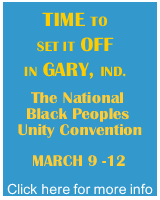 |
||||||||||||||
 |
||||||||||||||
 |
||||||||||||||
| |
||||||||||||||
| |
||||||||||||||






















